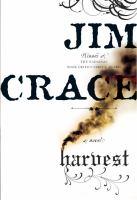
I confess, I was not immediately entranced by Harvest, and it was not until I started following the popular Downton Abbey television series that I began to appreciate the perspective presented in Jim Crace’s novel. This book offers a glimpse of life on the grounds beyond a great house during a time of modernization.
The story takes place in a secluded English village in some unspecified past, during a time when Inclosure Acts began allowing privatizing the open fields of English manors, and landowners transitioned from community crop harvests to more profitable forms of agriculture. Against this backdrop Crace tells the story of those who live on and work the land. Various unknown visitors disrupt the annual harvest celebration, and from the perspective of the Master’s man, William Thirsk, we witness the village's panic in the face of life-altering change. Relationships are explored and tested. There is no turning back to the old and familiar.
Admittedly, Harvest takes place likely a century or more before Downton, but I noticed a parallel where both stories describe a change in land use, motivated by financial gain. One prepares for sheep, the other pigs, but for both the livestock represents a new way of life. Where Downton portrays this change from the perspective of the estate’s managers, Harvest tells the story of those who more intimately care for and rely on the land.
Crace paints a picture with his lovely descriptive language. For me the story moved slowly, but the book is short and well worth reading, especially for anyone interested in literary or historical fiction. Crace gives a human face to the histories in textbooks.
